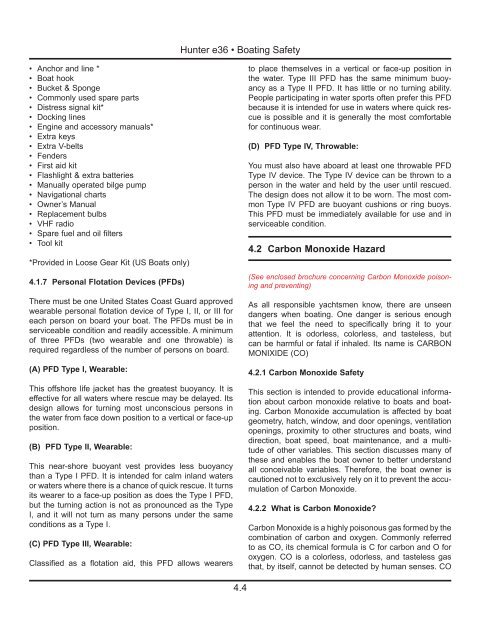36e Operator's Manual 2013.pdf - Marlow-Hunter, LLC
36e Operator's Manual 2013.pdf - Marlow-Hunter, LLC
36e Operator's Manual 2013.pdf - Marlow-Hunter, LLC
- No tags were found...
Create successful ePaper yourself
Turn your PDF publications into a flip-book with our unique Google optimized e-Paper software.
<strong>Hunter</strong> e36 • Boating Safety•••••••••••••••••••Anchor and line *Boat hookBucket & SpongeCommonly used spare partsDistress signal kit*Docking linesEngine and accessory manuals*Extra keysExtra V-beltsFendersFirst aid kitFlashlight & extra batteries<strong>Manual</strong>ly operated bilge pumpNavigational chartsOwner’s <strong>Manual</strong>Replacement bulbsVHF radioSpare fuel and oil filtersTool kit*Provided in Loose Gear Kit (US Boats only)4.1.7 Personal Flotation Devices (PFDs)There must be one United States Coast Guard approvedwearable personal flotation device of Type I, II, or III foreach person on board your boat. The PFDs must be inserviceable condition and readily accessible. A minimumof three PFDs (two wearable and one throwable) isrequired regardless of the number of persons on board.(A) PFD Type I, Wearable:This offshore life jacket has the greatest buoyancy. It iseffective for all waters where rescue may be delayed. Itsdesign allows for turning most unconscious persons inthe water from face down position to a vertical or face-upposition.(B) PFD Type II, Wearable:This near-shore buoyant vest provides less buoyancythan a Type I PFD. It is intended for calm inland watersor waters where there is a chance of quick rescue. It turnsits wearer to a face-up position as does the Type I PFD,but the turning action is not as pronounced as the TypeI, and it will not turn as many persons under the sameconditions as a Type I.(C) PFD Type III, Wearable:Classified as a flotation aid, this PFD allows wearersto place themselves in a vertical or face-up position inthe water. Type III PFD has the same minimum buoyancyas a Type II PFD. It has little or no turning ability.People participating in water sports often prefer this PFDbecause it is intended for use in waters where quick rescueis possible and it is generally the most comfortablefor continuous wear.(D) PFD Type IV, Throwable:You must also have aboard at least one throwable PFDType IV device. The Type IV device can be thrown to aperson in the water and held by the user until rescued.The design does not allow it to be worn. The most commonType IV PFD are buoyant cushions or ring buoys.This PFD must be immediately available for use and inserviceable condition.4.2 Carbon Monoxide Hazard(See enclosed brochure concerning Carbon Monoxide poisoningand preventing)As all responsible yachtsmen know, there are unseendangers when boating. One danger is serious enoughthat we feel the need to specifically bring it to yourattention. It is odorless, colorless, and tasteless, butcan be harmful or fatal if inhaled. Its name is CARBONMONIXIDE (CO)4.2.1 Carbon Monoxide SafetyThis section is intended to provide educational informationabout carbon monoxide relative to boats and boating.Carbon Monoxide accumulation is affected by boatgeometry, hatch, window, and door openings, ventilationopenings, proximity to other structures and boats, winddirection, boat speed, boat maintenance, and a multitudeof other variables. This section discusses many ofthese and enables the boat owner to better understandall conceivable variables. Therefore, the boat owner iscautioned not to exclusively rely on it to prevent the accumulationof Carbon Monoxide.4.2.2 What is Carbon Monoxide?Carbon Monoxide is a highly poisonous gas formed by thecombination of carbon and oxygen. Commonly referredto as CO, its chemical formula is C for carbon and O foroxygen. CO is a colorless, odorless, and tasteless gasthat, by itself, cannot be detected by human senses. CO4.4

















